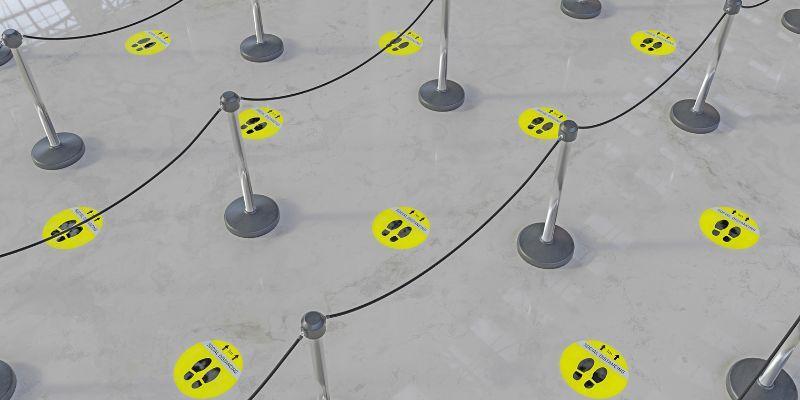Fan experience in sports stadiums is critical to ensure attendees have an enjoyable and memorable time. A positive experience makes fans more likely to return, nurtures loyalty to the team, and boosts revenue through ticket sales, merchandise, and concessions.
According to a Deloitte study, 78% of fans said that their overall stadium experience significantly influences their decision to attend future games. Boosting fan experience is thus vital for sports franchises’ sustained success and growth.
This article will explore various strategies and innovations for improving the fan experience at sports stadiums.
By focusing on comfortable seating, technology integration, entertainment, safety, and accessibility, stadiums can create an environment that fans will want to revisit time and time.
10 Strategies to Improve Fan Experience

Improving the fan experience at sports stadiums has become vital to the overall sports experience industry.
Considering this and other relevant factors that we will touch upon ahead, stadium visits can become a regular part of sports fans’ lives and contribute to stadium cash flow and growth. Let’s explore these in detail.
- Infrastructure and Facilities
- Digital Engagement
- Queue Management System
- Self-Service Kiosks
- Entertainment and Atmosphere
- Customer Service and Staff Training
- Ticketing and Access
- Safety and Security Measures
- Environmental Considerations
- Community Engagement
1. Infrastructure and Facilities
One of the most important aspects of improving the fan experience at sports stadiums is the quality of infrastructure and facilities. Comfortable seating is crucial; fans should have enough legroom, cushioned seats, and a good game view.
Modern stadiums also incorporate more premium seating options, such as suites and club seats, which offer added luxury and amenities.
Clean and accessible restrooms are another vital aspect. Fans expect restrooms to be well-maintained and easy to find. Adequate concessions with a variety of food and beverage options are essential. Diverse food choices, including healthy and local favorites, can enhance the fan experience significantly.
Stadiums should also consider climate control features like shaded areas or misting fans for hot weather and heaters for cold games. By investing in high-quality infrastructure and facilities, stadiums can significantly improve the overall fan experience and encourage repeat attendance.
2. Digital Engagement
Integrating technology into the fan experience can significantly improve enjoyment and convenience. Free, high-speed Wi-Fi allows fans to stay connected, share their experiences on social media, and access real-time game updates.
Mobile apps designed explicitly for the stadium can offer features like digital ticketing, interactive maps, and instant replays.
Augmented reality (AR) and virtual reality (VR) can provide unique, immersive experiences. Fans can use AR to see player statistics and game information overlaid on the live action or VR to experience the game from different perspectives, such as from the sidelines or even the locker room.
Additionally, large, high-definition screens and advanced sound systems can improve viewing and hearing the game, even from the furthest seats. By leveraging digital engagement tools, stadiums can create a more interactive and enjoyable experience for fans.
3. Queue Management System

Long lines can be a significant frustration for fans, whether they are waiting to enter the stadium, buy concessions, or use the restroom. Implementing an efficient queue management system can drastically improve the fan experience.
Technologies like mobile ordering for food and drinks allow fans to place their orders from their seats and receive notifications when their items are ready for pickup. This allows the fan experience at games to be further boosted.
Electronic ticketing systems with multiple entry points can speed up the entry process, reducing wait times. Additionally, crowd management software that monitors and directs fan movement can help prevent congestion in high-traffic areas.
Digital displays showing restroom and concession stand wait times can help fans make informed decisions and avoid unnecessary delays. By streamlining these processes and minimizing wait times, stadiums can create a smoother and more enjoyable experience for fans.
4. Self-Service Kiosks
Self-service kiosks are an excellent way to improve the fan experience at sports stadiums by providing convenience and reducing wait times. These kiosks can be strategically placed around the stadium to allow fans to order food, beverages, and merchandise quickly and efficiently without standing in long lines. Self-service kiosks can offer multiple advantages:
- Speed and Efficiency: Fans can place orders and make payments swiftly, which decreases the time they spend away from their seats.
- Customization: Kiosks can be customized to offer various languages, catering to a diverse fan base and ensuring everyone has a smooth experience.
- Reduced Errors: By allowing fans to input their orders, the chance of errors is minimized, leading to greater satisfaction with their purchases.
In addition to food and beverage orders, self-service kiosks can provide information about the stadium and upcoming events and even help navigate the venue. Stadiums can enhance convenience and modernize various processes by incorporating self-service kiosks, making the overall fan experience more enjoyable.
5. Entertainment and Atmosphere
Creating an engaging and lively atmosphere is essential for improving the fan experience at sports stadiums. Pre-game and halftime entertainment, such as live music, dance performances, and mascot interactions, can keep fans excited and engaged throughout the event.
Interactive activities and games, such as trivia contests and fan competitions, can add to the fun and make the experience more memorable.
- Fan Zones: Designated areas where fans can gather, socialize, and participate in interactive activities, creating a sense of community.
- Social Spaces: Lounges and social areas where fans can relax, mingle, and enjoy the game in a more casual setting.
Lighting and sound systems play a crucial role in enhancing the atmosphere. High-quality, synchronized light shows and sound effects can create a more immersive and thrilling environment.
Additionally, themed events and special promotions can add variety and excitement, encouraging fans to attend more games. Stadiums can create an environment that fans look forward to experiencing by focusing on entertainment and atmosphere.
6. Customer Service and Staff Training

Excellent customer service is fundamental to improving the fan experience at sports stadiums. Well-trained staff who are friendly, knowledgeable, and helpful can make a significant difference in how fans perceive their time at the stadium.
Comprehensive staff training programs ensure employees can handle various situations and provide top-notch service.
- Greeting and Assistance: Staff should greet fans warmly, provide directions, and assist with any issues promptly.
- Knowledgeable Staff: Employees should be well-informed about the stadium, the event, and any special promotions or activities, enabling them to answer questions and offer helpful information.
In addition to training, having sufficient staff members available during events is crucial. This ensures that fans receive timely assistance and that problems are addressed quickly.
7. Ticketing and Access
Streamlining ticketing and access processes is critical to improving the fan experience at sports stadiums.
Implementing advanced electronic ticketing systems allows fans to purchase, receive, and manage their tickets digitally, reducing the need for physical tickets and minimizing the risk of loss or fraud. This also simplifies entry procedures, as fans can use their smartphones to gain access quickly.
- Mobile Ticketing Apps: These apps can offer features like seat selection, upgrade options, and integration with digital wallets for easy payment.
- Multiple Entry Points: Having numerous entry gates with electronic scanners can reduce bottlenecks and shorten wait times, ensuring a smooth and efficient entry for fans.
Offering options such as season passes, family packages, and early bird discounts can also attract more fans and make the experience more affordable and appealing. By increasing ticketing and access, stadiums can provide a hassle-free start to the fan experience.
8. Safety and Security Measures
Ensuring the safety and security of fans is vital for a positive stadium experience. Visible security personnel and efficient security checks help fans feel safe and protected while attending events.
Implementing advanced security technologies, such as surveillance cameras, metal detectors, and bag scanners, can increase safety.
- Efficient Entry and Exit Procedures: Streamlined security checks and well-marked exits can help manage crowds and prevent congestion, especially in emergencies.
- Medical Facilities: On-site medical stations and trained staff are crucial for addressing any health-related incidents promptly and effectively.
Regular safety drills and clear communication of emergency procedures ensure that staff and fans are prepared for any situation. By prioritizing safety and security measures, stadiums can create an environment where fans can enjoy the event without concerns about their well-being.
9. Environmental Considerations

Incorporating environmentally friendly practices can significantly boost the fan experience at sports stadiums.
Fans are increasingly aware of environmental issues and appreciate efforts to reduce events’ ecological footprint. Implementing recycling programs, reducing single-use plastics, and promoting public transportation options can make a substantial impact.
- Sustainable Design: Using energy-efficient lighting, solar panels, and green building materials can reduce the stadium’s environmental impact and operational costs.
- Green Initiatives: Offering incentives for carpooling, providing bike racks, and encouraging the use of reusable containers for food and drinks.
Communicating these efforts to fans can create a sense of shared responsibility and pride in attending an environmentally conscious venue. Stadiums can appeal to eco-conscious fans and contribute to broader sustainability goals by focusing on environmental considerations.
10. Community Engagement
Engaging with the local community is essential for creating a loyal fan base and developing the stadium experience. Hosting community events, such as youth sports clinics, charity fundraisers, and open house days, can build strong connections between the team and the community.
- Local Partnerships: Collaborating with local businesses for sponsorships, food concessions, and promotional events can boost the local economy and enhance the fan experience.
- Fan Feedback: Actively seeking and incorporating feedback from fans can help stadiums understand their needs and make necessary improvements.
Creating programs recognizing and rewarding loyal fans, such as membership clubs or fan appreciation days, can also strengthen community ties.
Conclusion
Improving fan experience at sports stadiums is essential for building a loyal fan base and ensuring the long-term success of sports franchises.
By focusing on areas such as infrastructure and facilities, digital engagement, queue management systems, customer service, safety, environmental considerations, etc., stadiums can ensure that not only only do fans come back again , but also bring their friends along.
Enhancing these aspects makes attending games more enjoyable and boosts revenue through increased ticket sales, merchandise purchases, and concession sales.
By implementing these strategies to improve fan experience at sports stadiums, teams can ensure that every visit is memorable and positive for their fans.
BOOK A FREE DEMO





